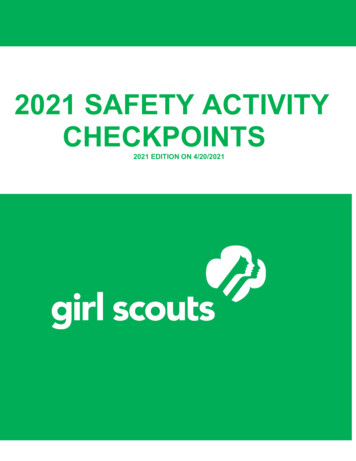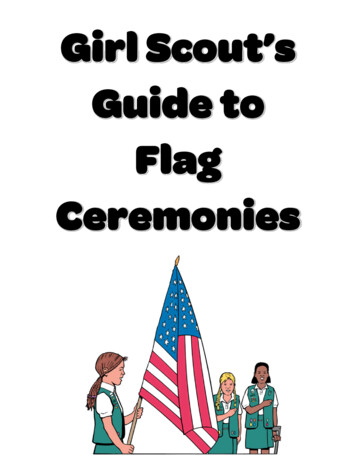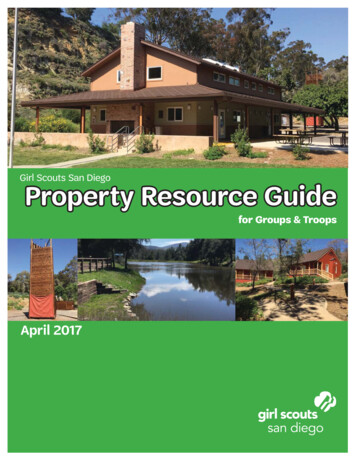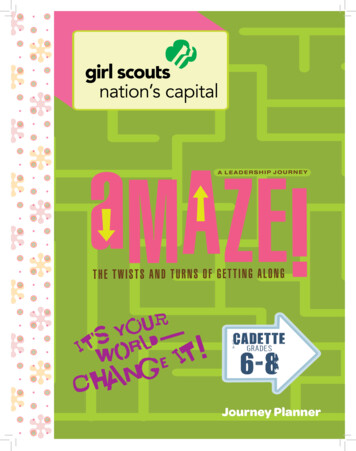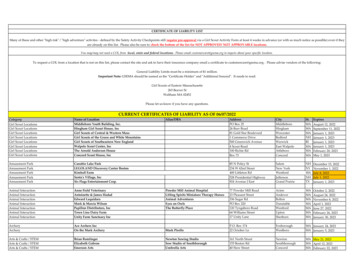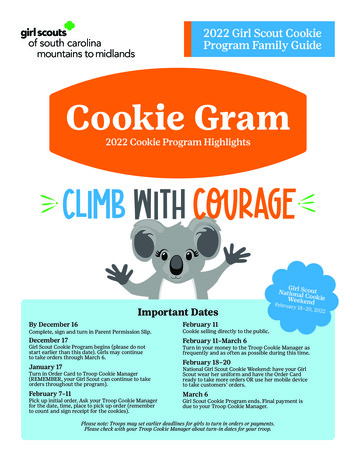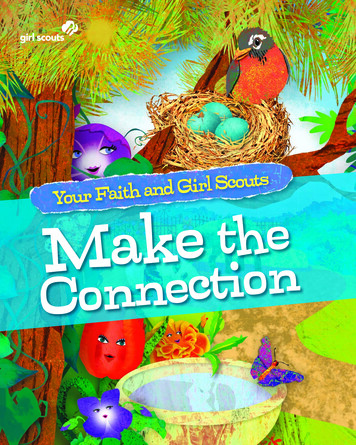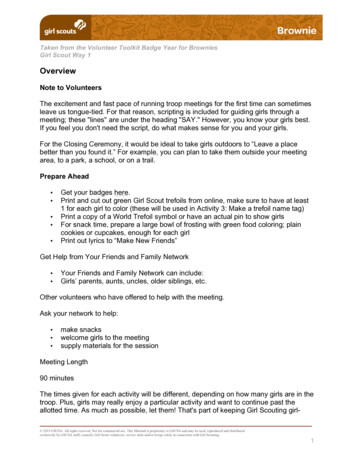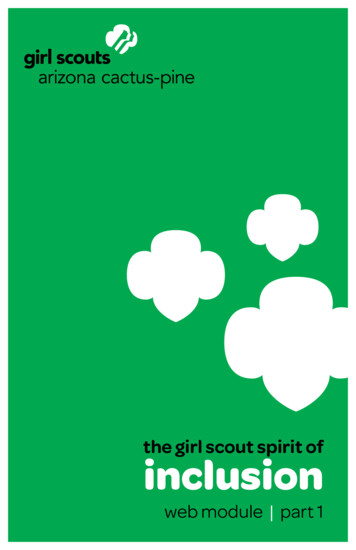
Transcription
the girl scout spirit ofinclusionweb module part 1
indexWhat Is Inclusion? . . . . . . . . . . . . . . . . . . . . . . . . . . . . . . . . . . . . . . . . 2ADA/What is a Disability?. . . . . . . . . . . . . . . . . . . . . . . . . . . . . . . . . 3Ability on Continuums. . . . . . . . . . . . . . . . . . . . . . . . . . . . . . . . . . . . 4Inclusion Empowerment Model. . . . . . . . . . . . . . . . . . . . . . . . . . 5Inclusion: What’s Expected as a Girl Scout Leader. . . . . . 7What Does Inclusion Look Like?. . . . . . . . . . . . . . . . . . . . . . . . . . 8Person-First Language. . . . . . . . . . . . . . . . . . . . . . . . . . . . . . . . . . . . 9Examples of First-Person Language . . . . . . . . . . . . . . . . . . . . . 11Myths & Facts . . . . . . . . . . . . . . . . . . . . . . . . . . . . . . . . . . . . . . . . . . . . 12Additional Resources. . . . . . . . . . . . . . . . . . . . . . . . . . . . . . . . . . . . 141
what is inclusion?The term “inclusion” closely follows the mission and purpose ofGirl Scouting. In fact, Girl Scouts–Arizona Cactus-Pine Council hasour own inclusivity statement:Girl Scouts–Arizona Cactus-Pine Council embraces pluralism andactively promotes inclusivity within our organization and the world.Inclusion means that all girls plan and participate in all activities,regardless of level of ability. Inclusion means girls with disabilitiesparticipate in activities alongside girls without disabilities, of thesame age and in the same troop or group. The inclusion of girlswith disabilities beside girls without disabilities benefits all girls.Everyone learns that she is more alike than different.2
what is a disability?The law does not define particular disabilities. The Americanswith Disabilities Act (ADA) ensures the same basic civil rights forpeople with disabilities that people without disabilities alreadyenjoy in housing, transportation, communications, and publicaccess to buildings and activities – including in Girl Scouting.The ADA protects any person who:»» Has a physical or mental impairment which substantiallylimits a major life activity»» Has a record of such impairment»» Is regarded as having such an impairmentThe ADA Title III»» Requires places of public accommodation to be accessibleand usable by people with disabilities»» Prohibits discrimination by private businesses in the “goods,services, facilities, procedures, privileges, advantages, andaccommodations offered to the public.”Who is the girl with a disability?»» A stranger’s daughter»» A neighbor’s niece»» A friend’s cousin»» Your daughter’s friend»» It could be your own childStrive for unity with inclusion. It’s not about “those girls,” it’sabout “our girls.”3
ability on continuumWithin each Girl Scout troop or group is a world of diversity anda wide variety of talents and abilities. Some girls can run fast andsome cannot. Some girls do well with activities requiring attentionto fine detail such as jewelry-making and illustration. Others excelin tasks like archery and canoeing. Some girls are outgoing, andothers are more introverted. All of the differences within the troopor group add to the excitement and rewards for the girls and theleaders. The challenge is to blend the differences together intoa cohesive whole, while allowing each girl to remain an individualwith her unique interests, talents and strengths.In an overall sense, the girl with a disability is not different from agirl without a disability. Simply, a girl with a disability is placed at adifferent location on a particular continuum. It is a mistake to thinkthat the disability will affect all continuums. An effective Girl Scoutleader will see each girl as having a combination of high and lowskill levels, and must shape activities so that all girls, regardless oftheir positions on the continuums, may participate. All Girl Scouts,both with and without disabilities, challenge the leader to becreative, sensitive, and energetic.As a leader, you may have noticed that each girl in your troop orgroup functions according to her individual ability in a particulararea. These ranges of ability form continuums and apply to girlswith disabilities as well as girls without disabilities. Each girl’s levelof skill will be located at a certain point on each continuum. Fivemajor continuums are important to the Girl Scout leader:1. Learning: the ability to understand new ideas and to masternew skills.2. Communication: the ability to read, understand, and conveyideas through speaking and writing.4
3. Motor and physical ability: the ability to move about, usetools, and manipulate objects.4. Emotional adjustment: the ability to accept personalstrengths and weaknesses and to react to situations in asocially appropriate manner.5. Sensory abilities: the capacity to hear, feel, see, smell andtaste.For example, girls who have difficulty using their hands are placedat the low end of the continuum on sewing and writing. However,these same girls may be able to speak in public very well and couldbe placed at the high end of the continuum when public speakingis the skill under consideration.examples of continuumsMotorusing their handscannotgrasp objectscan handleobjects w/ difficultycan manipulatesmall objects w/ ease - - - - - - - - - - - - - - - - - - - - - - - - - - - - - - - - - - - - - - - - using their feetcannotuse feet and legscan walkw/ difficultycan walk andrun w/ ease - - - - - - - - - - - - - - - - - - - - - - - - - - - - - - - - - - - - - - - - Communicationusing their voicedifficult to understandeasy to understand - - - - - - - - - - - - - - - - - - - - - - - - - - - - - - - - - - - - - - - - using the written worddifficult to understandeasy to understand - - - - - - - - - - - - - - - - - - - - - - - - - - - - - - - - - - - - - - - - 5
examples of continuums (cont’d)ability to see imagesseesnothingseesshadowsseesimagessees to readlarge printsees to readtypical print - - - - - - - - - - - - - - - - - - - - - - - - - - - - - - - - - - - - - - - - ability to hear soundshearsnothinghearsloud noiseshearsloud speechhearsmost speechhears speech/sounds easily - - - - - - - - - - - - - - - - - - - - - - - - - - - - - - - - - - - - - - - - By providing the needed support, the Girl Scout troop or groupcan include all girls no matter the diversity of their abilities. Notethat such support doesn’t always or necessarily require expertisein special education or therapeutic recreation, nor does it alwaysor necessarily require expensive adaptations or modifications(see inclusion module 2 for more information on adaptations).Inclusion in Girl Scouting follows an Empowerment Model:The Empowerment Model of Inclusion»» The problem is in the lack of supports»» The problem rests in the systems»» The solution is to develop supports»» The person in charge is the person with a disability»» The outcome is interdependence6
what’s expectedof a girl scout leader?Ensuring that all girls in your troop or group feel included requiresa willingness to get to know each girl, an interest in facilitatinginteraction, and a belief in the benefits of inclusion for everyone.Understand that inclusion is a process, not a product, and that itrequires flexibility, creativity and advance planning. In short, it’swhat you’re already doing as a Girl Scout troop leader!As a Girl Scout Troop Leader:»» Create an environment that values and respects diversity»» Model respectful ways to interact with all people»» Help facilitate friendships between the girls in your troop orgroup»» Recognize that all children have value7
what doesinclusion look like?Inclusion looks like a Girl Scout troop or group where girls withand without disabilities play, learn, and grow together. Inclusionmeans that regardless of ability, all girls in a troop are together,participating in the same activities, at all times. Inclusion involvesgirls with and without disabilities participating in Girl Scouting withpeers of the same age, in the troop level corresponding to theirschool grade. Inclusion is �»»Promotes acceptanceSupports self-determinationFacilitates positive, healthy relationshipsEmbraces differencesRequires collaboration, creativity and flexibilityRespects the entire familyInvolves same-age peersFocuses on outcomesWelcomes ALLRemember, inclusion is not a privilege nor is it separate from themission and values of the Girl Scout movement. Inclusion benefitsgirls with disabilities and their families, as well as girls withoutdisabilities and their families, the entire Girl Scouts organization,and the community as a whole.8
first person languageEveryone has unique personal characteristics. Emily is a child wholikes to swim. Mayra is a child who likes to play basketball and hasepilepsy. We are all different. Some of us wear eyeglass or contactlenses to help us see. Some people are short and some people aretall. We all look differently and learn differently. We should all beremembered for our accomplishments and our abilities, not ourlimitations. This is what makes us who we are and makes everyonevaluable.The Dos and Don’ts of EtiquetteDo refer to “people with disabilities.”Don’t label people with disabilities as a group.»» “The disabled”»» “The handicapped”Do put the person before the disability, and only mention thedisability when a girl needs special consideration or actionto accommodate it. Do emphasize a person’s abilities, notdisabilities.»» “Lily, the girl in my troop who is deaf, taught the troop how tosign the Girl Scout promise.”»» “Katie loves to sing.”Don’t use a disability to describe someone. Don’t mention thedisability unless it’s necessary.»» “The deaf girl in my troop.”»» “Katie’s epileptic, but she loves to sing.”Do allow a person with a disability to speak for herself. If a girl is notable to speak for herself, either she or her personal assistant will9
let you know. If you want to know about her disability, ask her– not the person standing next to her. And if she doesn’t wantto discuss her disability, respect her wishes and don’t keepasking.Don’t assume someone can’t speak for themselves.Do get to know the whole individual.Don’t base your opinion of a person on their disability.Always put the person before the disability. When you putthe person first, you are not only being more concise butyou are taking emphasis off a person’s physical or mentalcharacteristics. A good reminder is to use “have” verbs, ratherthan “be” verbs. Rather than saying a person “is blind,” or “isquadriplegic,” say the person “has a vision impairment,” or“has a mobility impairment.” Emphasize a person’s abilitiesand not her limitations.We do not use stereotypes with people that we respect. Thinkbefore you speak and remember the key concept is “personfirst language.”10
examples offirst person languageSay:Instead of:People with disabilities.The disabled or handicapped.Jasmine has a cognitive disability.Jasmine is mentally retarded.Olivia has autism.Olivia is autistic.Shayla has Down syndrome.Shayla’s Downs, or she’s aDowns person.Chloe has a learning disability.Chloe is learning disabled.Isabella has a physical disability.Isabella is quadriplegic orshe’s crippled.Charissa is of shortstature/she’s a little person.Charissa is a dwarf, or she’sa midget.Nora uses a wheelchair.Nora is confined to a wheelchair.Tania has a developmental delay.Tania is developmentally delayed.Jenny communicateswith her eyes/device/etc.Jenny is non-verbal.Claudia has a brain injury.Claudia is brain damaged.Allie receives specialeducation services.Allie is special ed.Mia needs. Or Mia uses Mia has problems. Mia hasspecial needs.Children without disabilities.Normal/healthy/regular children.11
myths & facts aboutgirls with disabilitiesMyth 1: Girls with disabilities are brave and courageous.Fact: Adjusting to a disability requires adapting to a lifestyle, notbravery and courage.Myth 2: Girls with disabilities are more comfortable with “their ownkind.”Fact: In the past, grouping people with disabilities in separateschools and institutions reinforced this misconception. Today,many people with disabilities take advantage of new opportunitiesto join mainstream society.Myth 3: Girls with disabilities always need help.Fact: Many people with disabilities are independent andcapable of giving help. If you would like to help someone with adisability, ask if he or she needs it before you act. Anyone mayoffer assistance, but most people with disabilities prefer to beresponsible for themselves.Myth 4: All persons who use wheelchairs are chronically ill or sickly.Fact: The association between wheelchair use and illness mayhave evolved through hospitals using wheelchairs to transport sickpeople. A person may use a wheelchair for a variety of reasons,none of which may have anything to do with lingering illness.Myth 5: Wheelchair use is confining; people who use wheelchairsare “wheelchair-bound.”Fact: A wheelchair, like a bicycle or an automobile, is a personalassistive device that enables someone to get around.12
Myth 6: All persons with hearing disabilities can read lips.Fact: Lip-reading skills vary among people who use them and arenever entirely reliable.Myth 7: People who are blind acquire a “sixth sense.”Fact: Although most people who are blind develop their remainingsenses more fully, they do not have a “sixth sense.”Myth 8: The lives of girls with disabilities are totally different thanthe lives of girls without disabilities.Fact: Girls with disabilities go to school, play sports, do chores,laugh, cry, get angry, have close friendships, have families, careabout others, plan and dream like girls everywhere.Myth 9: There is nothing one person can do to help eliminate thebarriers confronting girls with disabilities.Fact: Everyone can contribute to change. You can help removebarriers by:»» Understanding the need for accessible parking and leaving itfor those who need it»» Encouraging participating of people with disabilities incommunity activities by using accessible meeting and eventsites»» Understanding children’s curiosity about disabilities andpeople who have them»» Advocating a barrier-free environment»» Speaking up when negative words or phrases are used aboutdisability»» Accepting people with disabilities as individuals capable ofthe same needs and feelings as yourself, and hiring qualifiedpersons with disabilities whenever possible.13
additional resourceson inclusionKids Included Togetherwww.kitonline.orgEaster Sealswww.easterseals.com/site/PageServer?pagename ntl homepageDisability Is Naturalwww.disabilityisnatural.comThe Center for an Accessible Societywww.accessiblesociety.orgRaising Special Kidswww.raisingspecialkids.org/default.aspx14
119 E Coronado RoadPhoenix, AZ 85004602.452.7000800.352.6133girlscoutsaz.org
Chloe has a learning disability . Chloe is learning disabled . Isabella has a physical disability . Isabella is quadriplegic or she's crippled . Charissa is of short Charissa is a dwarf, or she's stature/she's a little person . a midget . Nora uses a wheelchair . Nora is confined to a wheelchair . Tania has a developmental delay .

